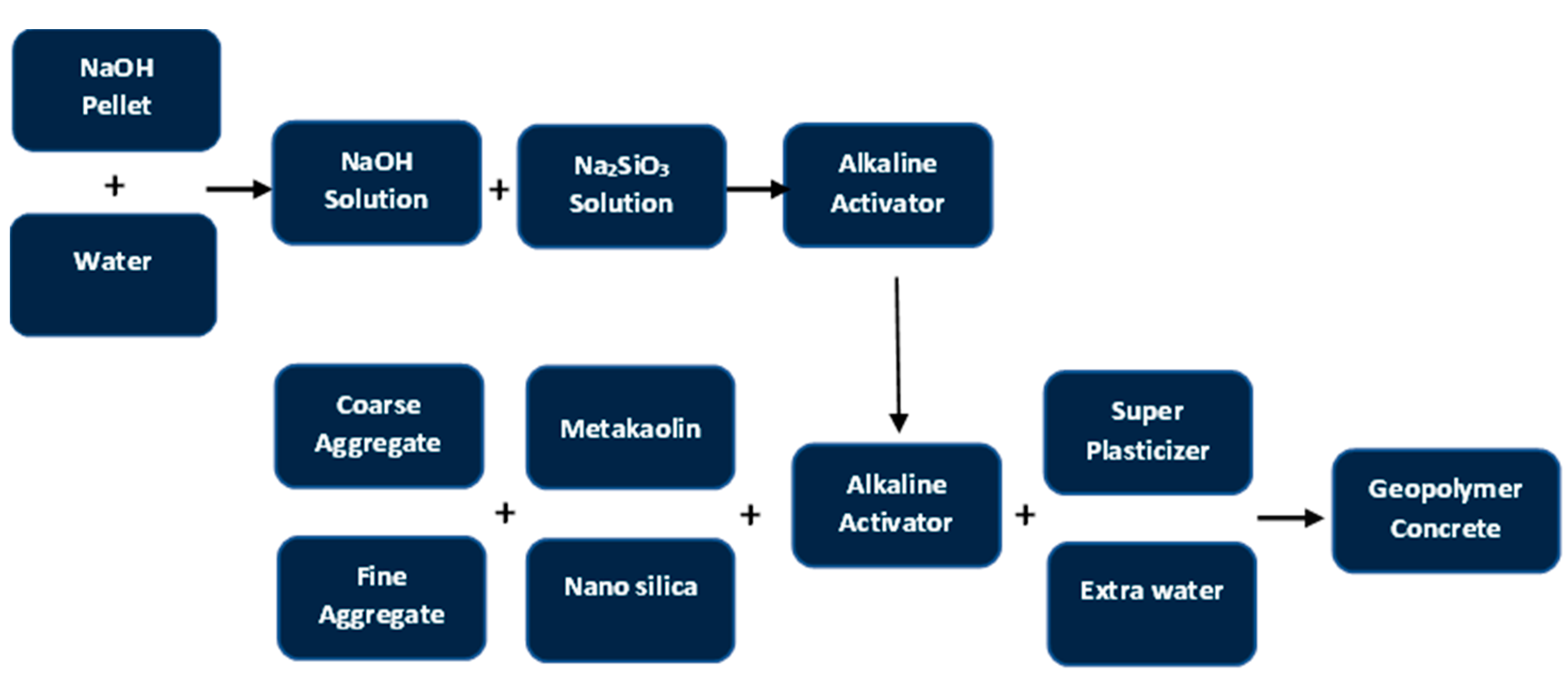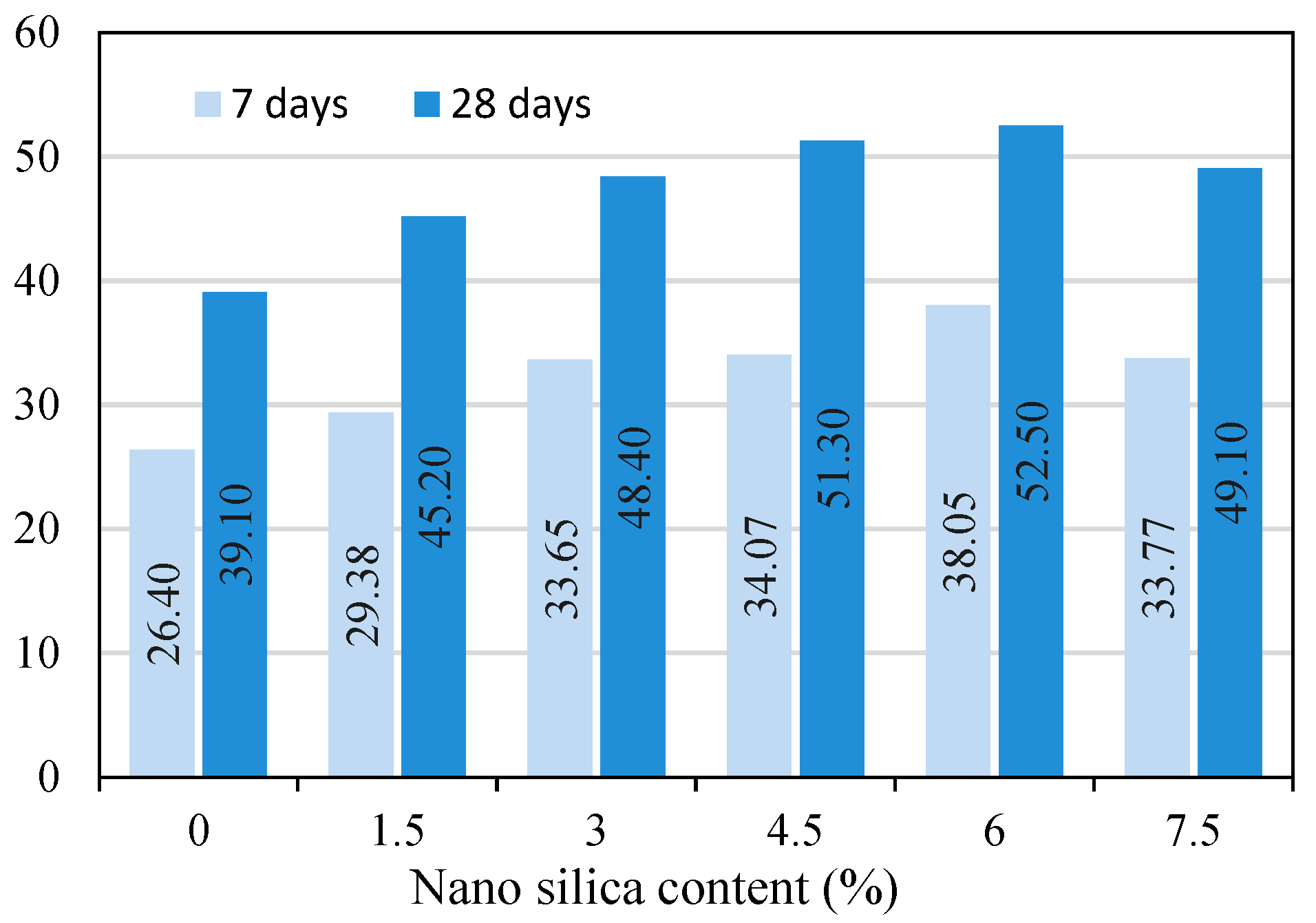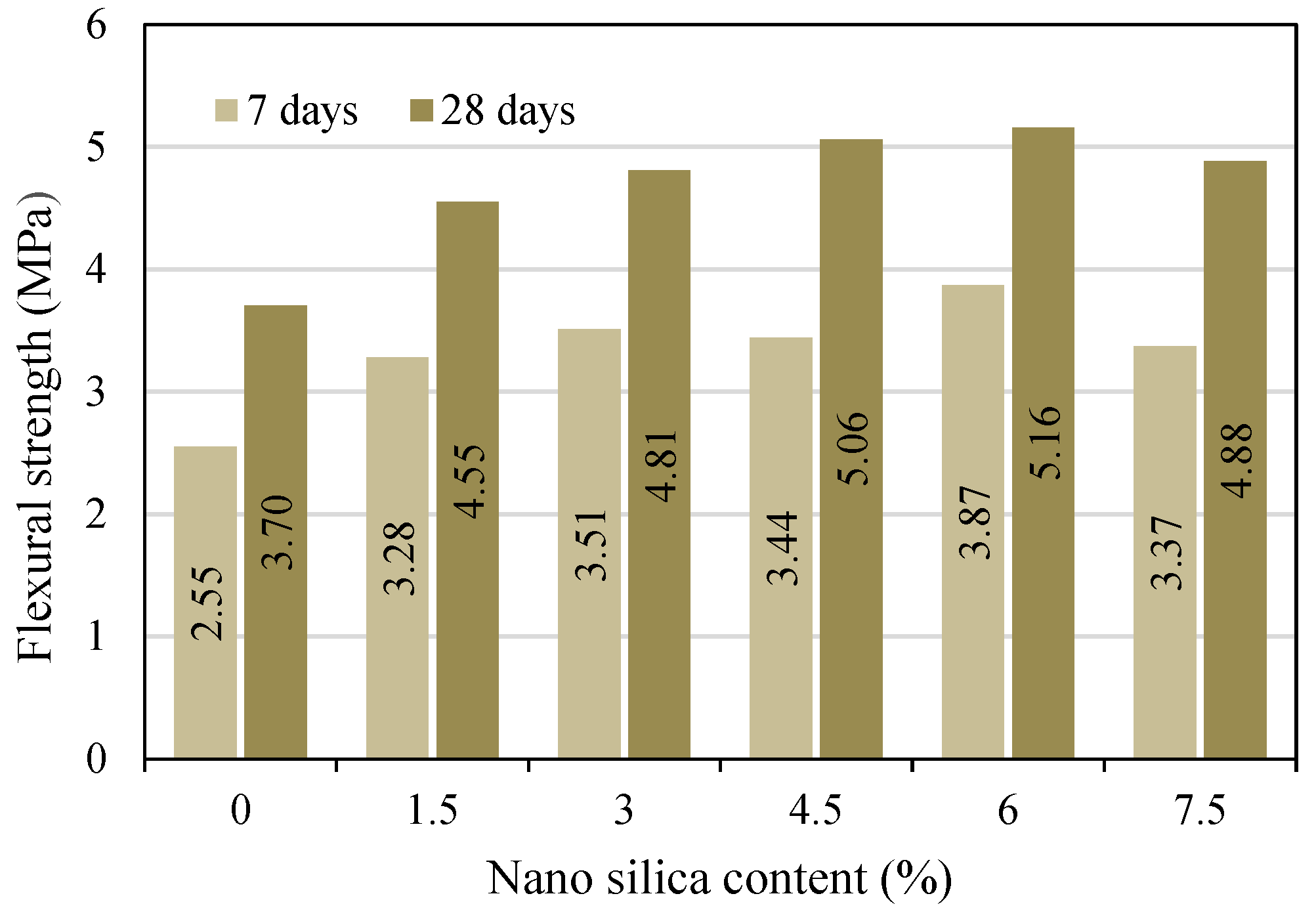Sustainable Alternatives to Cement: Synthesizing Metakaolin-Based Geopolymer Concrete Using Nano-Silica
Abstract
:1. Introduction
2. Materials and Methods
2.1. Materials
2.1.1. Geopolymer Concrete Properties
2.1.2. Nano-Silica (NS) Properties
2.2. Mix Proportions of Materials
2.3. Casting and Curing of Geopolymer Concrete
2.4. Testing Procedures
3. Results and Discussion
3.1. Slump Test
3.2. Compressive Strength
3.3. Tensile Strength
3.4. Flexural Strength
4. Statistical Analysis
5. Conclusions
- The addition of NS to MK-based GC can result in a reduction in slumps. This is because NS has a smaller size and a higher specific surface area than other materials, and it increases the aspect ratio in the concrete.
- The inclusion of NS in MK-based GC improved the mechanical properties to a percentage of 6.0%. Adding more than 6.0% of NS decreased the mechanical strength of the geopolymer compared to the optimal value of 6.0%.
- The current study revealed that 6.0% NS was the optimal percentage for producing a local MK-based GC with acceptable mechanical properties.
- It was discovered that adding 6% NS to MK-based GC and curing it at ambient temperature resulted in a 34.4% increase in its compressive strength compared to the control mix. Furthermore, the split tensile strength and flexural strength showed an improvement of 37% and 39.4%, respectively, compared to their respective control geopolymer strengths.
- Strong positive correlations (0.82, 0.84, and 0.81) were found between NS percentage and compressive, tensile, and flexural strength, indicating a robust relationship. The low p-values (0.045, 0.033, and 0.048) indicate statistical significance (<0.05). Adjusted R-square values (0.59, 0.65, and 0.58) suggest that a significant portion of the variations in strength (59%, 65%, and 58%) can be attributed to the percentage of NS.
- The findings of this study highlight the promising mechanical characteristics of GC synthesized from MK and NS, positioning it as a viable option for concrete construction applications. The versatility of GC makes it suitable for use in diverse sectors. However, to fully exploit its potential, there is a need for further research in several key areas. Future investigations should focus on analyzing the microstructure of GC, evaluating long-term durability properties, and studying time-dependent deformations such as creep and shrinkage. By addressing these aspects, we can enhance our understanding of GC and contribute a successful implementation in the construction industry.
Author Contributions
Funding
Data Availability Statement
Conflicts of Interest
References
- McCaffrey, R. Climate change and the cement industry. Global Cement and Lime Magazine, 9 September 2009; pp. 99–117. [Google Scholar]
- McLellan, B.C.; Williams, R.P.; Lay, J.; Van Riessen, A.; Corder, G.D. Costs and carbon emissions for geopolymer pastes in comparison to ordinary portland cement. J. Clean. Prod. 2011, 19, 1080–1090. [Google Scholar] [CrossRef] [Green Version]
- Tennakoon, C.; Shayan, A.; Sanjayan, J.G.; Xu, A. Chloride ingress and steel corrosion in geopolymer concrete based on long term tests. Mater. Des. 2017, 116, 287–299. [Google Scholar] [CrossRef]
- Nagajothi, S.; Elavenil, S.; Angalaeswari, S.; Natrayan, L.; Mammo, W.D. Durability studies on fly ash based geopolymer concrete incorporated with slag and alkali solutions. Adv. Civ. Eng. 2022, 2022, 7196446. [Google Scholar] [CrossRef]
- Singh, B.; Ishwarya, G.; Gupta, M.; Bhattacharyya, S.K. Geopolymer concrete: A review of some recent developments. Constr. Build. Mater. 2015, 85, 78–90. [Google Scholar] [CrossRef]
- Junaid, M.T.; Kayali, O.; Khennane, A.; Black, J. A mix design procedure for low calcium alkali activated fly ash-based concretes. Constr. Build. Mater. 2015, 79, 301–310. [Google Scholar] [CrossRef]
- Phoo-ngernkham, T.; Maegawa, A.; Mishima, N.; Hatanaka, S.; Chindaprasirt, P. Effects of sodium hydroxide and sodium silicate solutions on compressive and shear bond strengths of FA—GBFS geopolymer. Constr. Build. Mater. 2015, 91, 1–8. [Google Scholar] [CrossRef]
- Kumar, S.; Kumar, R.; Mehrotra, S.P. Influence of granulated blast furnace slag on the reaction, structure and properties of fly ash based geopolymer. J. Mater. Sci. 2010, 45, 607–615. [Google Scholar] [CrossRef]
- Aredes, F.G.M.; Campos, T.M.B.; Machado, J.P.B.; Sakane, K.K.; Thim, G.P.; Brunelli, D.D. Effect of cure temperature on the formation of metakaolinite-based geopolymer. Ceram. Int. 2015, 41, 7302–7311. [Google Scholar] [CrossRef]
- Ozer, I.; Soyer-Uzun, S. Relations between the structural characteristics and compressive strength in metakaolin based geopolymers with different molar Si/Al ratios. Ceram. Int. 2015, 41, 10192–10198. [Google Scholar] [CrossRef]
- Rafeet, A.; Vinai, R.; Soutsos, M.; Sha, W. Guidelines for mix proportioning of fly ash/GGBS based alkali activated concretes. Constr. Build. Mater. 2017, 147, 130–142. [Google Scholar] [CrossRef] [Green Version]
- Ma, C.-K.; Awang, A.Z.; Omar, W. Structural and material performance of geopolymer concrete: A review. Constr. Build. Mater. 2018, 186, 90–102. [Google Scholar] [CrossRef]
- Ng, C.; Alengaram, U.J.; Wong, L.S.; Mo, K.H.; Jumaat, M.Z.; Ramesh, S. A review on microstructural study and compressive strength of geopolymer mortar, paste and concrete. Constr. Build. Mater. 2018, 186, 550–576. [Google Scholar] [CrossRef]
- Shivaprasad, K.N.; Das, B.B. Determination of optimized geopolymerization factors on the properties of pelletized fly ash aggregates. Constr. Build. Mater. 2018, 163, 428–437. [Google Scholar] [CrossRef]
- Tuyan, M.; Andiç-Çakir, Ö.; Ramyar, K. Effect of alkali activator concentration and curing condition on strength and microstructure of waste clay brick powder-based geopolymer. Compos. Part B Eng. 2018, 135, 242–252. [Google Scholar] [CrossRef]
- Pouhet, R.; Cyr, M. Formulation and performance of flash metakaolin geopolymer concretes. Constr. Build. Mater. 2016, 120, 150–160. [Google Scholar] [CrossRef]
- Sumesh, M.; Alengaram, U.J.; Jumaat, M.Z.; Mo, K.H.; Alnahhal, M.F. Incorporation of nano-materials in cement composite and geopolymer based paste and mortar—A review. Constr. Build. Mater. 2017, 148, 62–84. [Google Scholar] [CrossRef]
- Stefanidou, M.; Tsardaka, E.-C.; Pavlidou, E. Influence of nano-silica and nano-alumina in lime-pozzolan and lime-metakaolin binders. Mater. Today Proc. 2017, 4, 6908–6922. [Google Scholar] [CrossRef]
- Mohammed, B.S.; Adamu, M. Mechanical performance of roller compacted concrete pavement containing crumb rubber and nano silica. Constr. Build. Mater. 2018, 159, 234–251. [Google Scholar] [CrossRef]
- Gao, D.; Chang, R.; Lyu, B.; Ma, J.; Duan, X. Preparation of epoxy-acrylate copolymer/nano-silica via Pickering emulsion polymerization and its application as printing binder. Appl. Surf. Sci. 2018, 435, 195–202. [Google Scholar] [CrossRef]
- Khater, H.M.M. Physicomechanical properties of nano-silica effect on geopolymer composites. J. Build. Mater. Struct. 2016, 3, 1–14. Available online: https://www.asjp.cerist.dz/en/downArticle/292/3/1/10061 (accessed on 15 March 2023). [CrossRef]
- Khater, H.M. Effect of nano-silica on microstructure formation of low-cost geopolymer binder. Nanocomposites 2016, 2, 84–97. [Google Scholar] [CrossRef] [Green Version]
- Phoo-ngernkham, T.; Chindaprasirt, P.; Sata, V.; Hanjitsuwan, S.; Hatanaka, S. The effect of adding nano-SiO2 and nano-Al2O3 on properties of high calcium fly ash geopolymer cured at ambient temperature. Mater. Des. 2014, 55, 58–65. [Google Scholar] [CrossRef]
- Gao, K.; Lin, K.-L.; Wang, D.; Hwang, C.-L.; Tuan, B.L.A.; Shiu, H.-S.; Cheng, T.W. Effect of nano-SiO2 on the alkali-activated characteristics of metakaolin-based geopolymers. Constr. Build. Mater. 2013, 48, 441–447. [Google Scholar] [CrossRef]
- ASTM C618; Standard Specification for Coal Fly Ash and Raw or Calcined Natural Pozzolan for Use. ASTM International: West Conshohocken, PA, USA, 2010.
- ASTM C127; Standard Test Method for Relative Density (Specific Gravity) and Absorption of Coarse Aggregate. ASTM International: West Conshohocken, PA, USA, 2015. Available online: https://global.ihs.com/doc_detail.cfm?document_name=ASTMC127&item_s_key=00014322 (accessed on 12 June 2021).
- Mohmmad, S.H.; Gülcsan, M.E.; Çevik, A. Behaviour of Geopolymer Concrete Two-Way Slabs Reinforced by FRP Bars after Exposure to Elevated Temperatures. Arab. J. Sci. Eng. 2022, 47, 12399–12421. [Google Scholar] [CrossRef]
- Davidovits, J. Geopolymer Cement a Review, Published in Geopolymer Science and Technics, Technical Paper #21, Geopolymer Institute Library. 2013. Available online: www.geopolymer.org (accessed on 18 March 2023).
- Olivia, M.; Nikraz, H. Properties of fly ash geopolymer concrete designed by Taguchi method. Mater. Des. 2012, 36, 191–198. [Google Scholar] [CrossRef] [Green Version]
- ASTM C143/C143M; Standard Test Method for Slump of Hydraulic-Cement Concrete. ASTM International: West Conshohocken, PA, USA, 2020.
- ASTM C39/C39M-21; Test Method for Compressive Strength of Cylindrical Concrete Specimens. ASTM International: West Conshohocken, PA, USA, 2021.
- ASTM C496/C496M-17; Standard Test Method for Splitting Tensile Strength of Cylindrical Concrete Specimens1. ASTM International: West Conshohocken, PA, USA, 2017.
- RILEM 50-FMC/198. Determination of the Fracure Energy of Mortar and Concrete by Means of Three-point Bend Test on Notched Beams. Mater. Struct. 1985, 18, 285–290. [Google Scholar]
- Akcay, B.; Tasdemir, M.A. Optimisation of using lightweight aggregates in mitigating autogenous deformation of concrete. Constr. Build. Mater. 2009, 23, 353–363. [Google Scholar] [CrossRef]
- Shahrajabian, F.; Behfarnia, K. The effects of nano particles on freeze and thaw resistance of alkali-activated slag concrete. Constr. Build. Mater. 2018, 176, 172–178. [Google Scholar] [CrossRef]
- Zidi, Z.; Ltifi, M.; Zafar, I. Characterization of nano-silica local metakaolin based-geopolymer: Microstructure and mechanical properties. Open J. Civ. Eng. 2020, 10, 143. [Google Scholar] [CrossRef]
- Deb, P.S.; Sarker, P.K.; Barbhuiya, S. Effects of nano-silica on the strength development of geopolymer cured at room temperature. Constr. Build. Mater. 2015, 101, 675–683. [Google Scholar] [CrossRef]
- Ravitheja, A.; Kiran Kumar, N.L.N. Effect of nano-silica and GGBS on the strength properties of fly ash-based geopolymers. In Sustainable Construction and Building Materials: Select Proceedings of ICSCBM 2018; Springer: Singapore, 2018; pp. 449–458. [Google Scholar] [CrossRef]
- Kord, B.; Ghalehno, M.D.; Movahedi, F. Effect of surface functionalization of SiO2 nanoparticles on the dynamic mechanical, thermal and fire properties of wheat straw/LDPE composites. J. Polym. Environ. 2020, 28, 304–316. [Google Scholar] [CrossRef]
- Sathvik, S.; Shakor, P.; Hasan, S.; Awuzie, B.O.; Singh, A.K.; Rauniyar, A.; Karakouzian, M. Evaluating the potential of geopolymer concrete as a sustainable alternative for thin white-topping pavement. Front. Mater. 2023, 10, 1181474. [Google Scholar] [CrossRef]







| Sieve Size (mm) | 16 | 8 | 4 | 2 | 1 | 0.5 | 0.25 | Fineness Modules | Specific Gravity | Absorption |
|---|---|---|---|---|---|---|---|---|---|---|
| Fine Aggregate | 100 | 100 | 84.1 | 49.6 | 30.5 | 14.5 | 3.8 | 2.46 | 2.51 | 2.8 |
| Coarse Aggregate | 100 | 67.9 | 2.4 | 0 | 0 | 0 | 0 | 5.77 | 2.67 | 1.7 |
| Component | CaO | Na2O | K2O | SiO2 | Fe2O3 | Al2O3 | MgO | SO3 | Specific Gravity | Blaine Fineness (m2/kg) |
|---|---|---|---|---|---|---|---|---|---|---|
| MK (%) | 39.4 | 0.28 | 1.23 | 53.7 | 4.7 | 32.1 | 0.87 | - | 2.45 | 379 |
| Component | Phase | Form | Size (nm) | Density (g/cm3) | Porosity | Content of SiO2 | Specific Gravity |
|---|---|---|---|---|---|---|---|
| NS (%) | Non-crystal | sphere | 14–20 | 0.17 | Nonporous | 99.9% | 1.30–1.32 |
| Mix | MK | Fine Agg. | Coarse Agg. | Na2SiO3 + NaOH | Water | SP | Na2SiO3/NaOH | Alkali/Binder | NS% |
|---|---|---|---|---|---|---|---|---|---|
| M0 | 380 | 720 | 920 | 190 | 30 | 19 | 2.5 | 0.5 | 0 |
| M-NS1.5 | 380 | 720 | 920 | 190 | 30 | 19 | 2.5 | 0.5 | 1.5 |
| M-NS3.0 | 380 | 720 | 920 | 190 | 30 | 19 | 2.5 | 0.5 | 3.0 |
| M-NS4.5 | 380 | 720 | 920 | 190 | 30 | 19 | 2.5 | 0.5 | 4.5 |
| M-NS6.0 | 380 | 720 | 920 | 190 | 30 | 19 | 2.5 | 0.5 | 6.0 |
| M-NS7.5 | 380 | 720 | 920 | 190 | 30 | 19 | 2.5 | 0.5 | 7.5 |
| Mechanical Properties | |||
|---|---|---|---|
| Compressive Strength | Tensile Strength | Flexural Strength | |
| Multiple R | 0.821 | 0.848 | 0.815 |
| R Square | 0.674 | 0.720 | 0.664 |
| Adjusted R Square | 0.592 | 0.650 | 0.580 |
| Significance F | 0.045 | 0.033 | 0.048 |
| NS (p-value) | 0.045 | 0.033 | 0.048 |
| NS (correlation) | 0.821 | 0.848 | 0.814 |
Disclaimer/Publisher’s Note: The statements, opinions and data contained in all publications are solely those of the individual author(s) and contributor(s) and not of MDPI and/or the editor(s). MDPI and/or the editor(s) disclaim responsibility for any injury to people or property resulting from any ideas, methods, instructions or products referred to in the content. |
© 2023 by the authors. Licensee MDPI, Basel, Switzerland. This article is an open access article distributed under the terms and conditions of the Creative Commons Attribution (CC BY) license (https://creativecommons.org/licenses/by/4.0/).
Share and Cite
Mohmmad, S.H.; Shakor, P.; Muhammad, J.H.; Hasan, M.F.; Karakouzian, M. Sustainable Alternatives to Cement: Synthesizing Metakaolin-Based Geopolymer Concrete Using Nano-Silica. Constr. Mater. 2023, 3, 276-286. https://doi.org/10.3390/constrmater3030018
Mohmmad SH, Shakor P, Muhammad JH, Hasan MF, Karakouzian M. Sustainable Alternatives to Cement: Synthesizing Metakaolin-Based Geopolymer Concrete Using Nano-Silica. Construction Materials. 2023; 3(3):276-286. https://doi.org/10.3390/constrmater3030018
Chicago/Turabian StyleMohmmad, Sarwar H., Pshtiwan Shakor, Jaza H. Muhammad, Mustafa F. Hasan, and Moses Karakouzian. 2023. "Sustainable Alternatives to Cement: Synthesizing Metakaolin-Based Geopolymer Concrete Using Nano-Silica" Construction Materials 3, no. 3: 276-286. https://doi.org/10.3390/constrmater3030018






